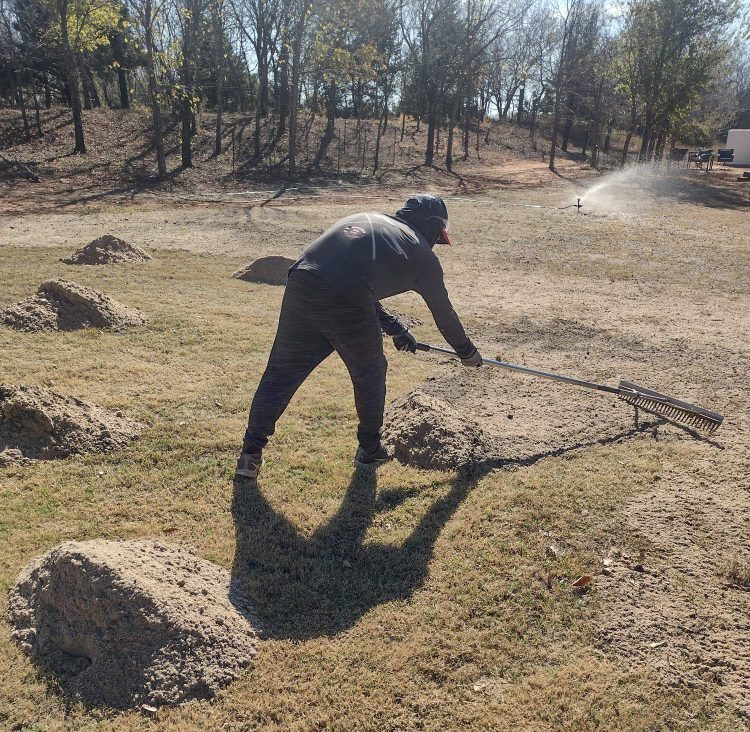You’ve noticed them all summer: those annoying low spots that collect water after every rain, the uneven patches that make mowing a challenge, and maybe even that slight slope that’s gotten more pronounced over the years. As temperatures drop and leaves begin to fall, you might think fall lawn leveling care can wait until spring. The reality is quite different. Fall represents your best window for addressing lawn unevenness, and taking action now can save you significant time, money, and frustration when warm weather returns. At Accurate Lawn Leveling, we’ve spent years helping homeowners understand that autumn isn’t just about raking leaves—it’s about setting the foundation for a healthier, more resilient lawn come spring.
The science behind fall lawn preparation is straightforward yet compelling. During autumn months, grass roots continue growing even as top growth slows, which means any leveling work you do now gives your lawn maximum time to establish itself before winter dormancy sets in. When you address unevenness in fall, you’re essentially giving your yard a three-month head start on recovery. Research from turf management specialists indicates that fall-leveled lawns show up to forty percent better spring recovery rates compared to those leveled in spring or summer, primarily because the cooler temperatures reduce stress on grass while moisture levels remain more consistent.

Understanding What Winter Does to Uneven Lawns
Winter weather doesn’t just pause lawn problems—it amplifies them. Those low spots you’ve been tolerating become miniature ice rinks when temperatures drop, and the freeze-thaw cycles common in late winter can actually worsen existing unevenness. Water pools in depressions, freezes overnight, expands, and gradually separates soil layers in ways that create even deeper valleys by spring. Meanwhile, raised areas experience more exposure to harsh winds and temperature extremes, which can lead to crown damage and thinning grass coverage. Your lawn essentially spends three months experiencing stress in all the wrong places.
The compounding effect of winter on uneven terrain also impacts drainage patterns throughout your entire property. As snow melts and spring rains arrive, established low points channel water in predictable paths that can erode soil, damage nearby landscaping, and even threaten foundation integrity if they’re close to your home. Addressing these issues in fall means you’re protecting more than just your lawn’s appearance—you’re safeguarding your property’s structural health and preventing costly remediation work down the road.
The Fall Advantage for Lawn Leveling Work
Soil conditions in autumn create ideal circumstances for leveling projects. The ground retains enough warmth for easy working but isn’t baked hard from summer heat, which means topdressing materials integrate more effectively with existing soil. Moisture levels tend to be more consistent during fall months, eliminating the concern about either working with dust-dry soil or waiting weeks for saturated ground to become workable. These conditions allow for more precise leveling work that achieves better long-term results.
Cool-season grasses, which dominate much of the country, actively thrive during fall temperatures. When you level your lawn in autumn, you’re working with biology rather than against it. The grass naturally wants to grow and establish roots during this period, which means it responds enthusiastically to the improved conditions leveling provides. Even warm-season grasses, while preparing for dormancy, benefit from fall leveling because the work is complete and settled before they begin their spring growth surge.
What Proper Fall Leveling Involves
Professional lawn leveling goes well beyond simply dumping soil on low spots and hoping for the best. The process begins with careful assessment of your yard’s topography, drainage patterns, and underlying causes of unevenness. Sometimes settling occurs because of poor initial grading, while other cases involve soil compaction from heavy foot traffic or decomposed organic matter like old tree roots. Understanding why your lawn became uneven informs how we address it effectively.
Quality leveling work uses carefully selected topdressing materials that match your existing soil composition and support healthy grass growth. The mixture typically combines topsoil, compost, and sand in proportions designed to improve drainage while providing nutrients. Application happens in thin layers—usually no more than half an inch at a time—because grass can successfully grow through modest amounts of topdressing but struggles when buried too deeply. For severely uneven areas, we sometimes recommend addressing the problem in stages across multiple seasons rather than risking grass health with excessive topdressing at once.
Moving Forward With Confidence
Your lawn tells you when it needs help, and those persistent uneven areas represent a clear message that shouldn’t be ignored. Fall gives you a natural opportunity to address these issues while working with seasonal advantages that make the job easier and more effective. The investment you make in proper leveling now pays dividends in easier maintenance, better curb appeal, and genuine peace of mind knowing your property is protected against winter’s harsh treatment of uneven terrain.
We understand that lawn care decisions involve both practical considerations and emotional investment in your home’s appearance. Taking the first step toward a level, healthy lawn doesn’t need to feel overwhelming. Accurate Lawn Leveling offers free assessments that give you clear information about your yard’s specific needs and realistic timelines for addressing them. Reach out today, and let’s work together to prepare your lawn for winter success and spring beauty. Your future self—and your lawn mower—will thank you.
